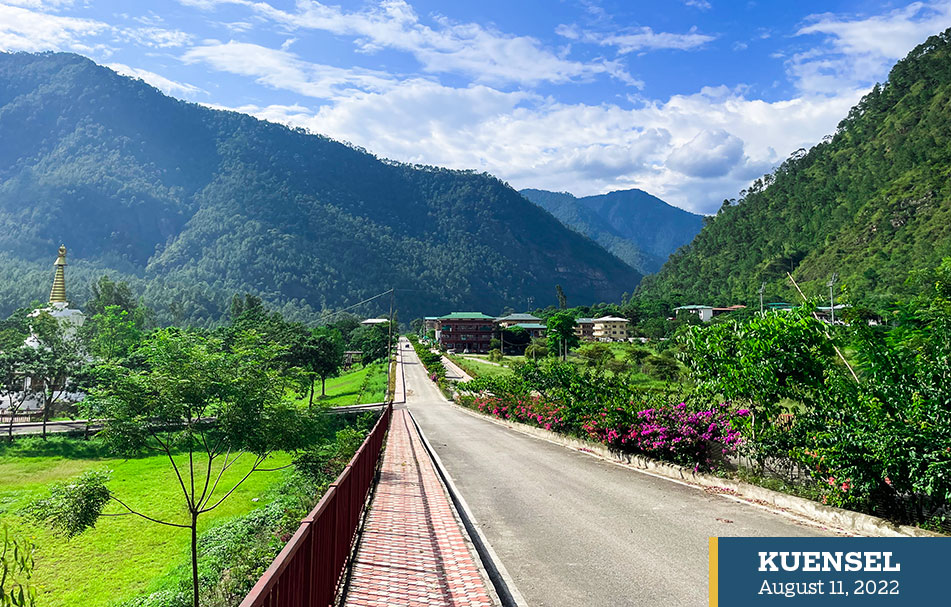[ad_1]
The small sleepy town has suddenly boomed bringing business and hope
Tshering Namgyal | Gyalpoizhing
A well-maintained park stretching for more than 16 acres, smooth roads divided by a line of flowers, a football ground in artificial turf, neatly maintained footpaths and many more have transformed Gyalpoizhing beyond recognition for visitors coming after a decade to the town.
Business is thriving with the once sleepy hot town becoming the preferred place for business, as more and more government institutions, regional offices of corporate bodies, and state-owned enterprises bring with them people, business and hope.
Once a mosquito and snake-infested place, Gyalpoizhing town, is poised to become the commercial hub of eastern Bhutan if it is not already. The town’s growth began in the mid-1990s following the commencement of Kurichhu Hydropower Corporation Limited (KHPCL) in 1992.
It is now not the town that many would have even imagined. And it has evolved over time.
The completion of the 77-km Gyalpoizhing-Nganglam highway has become the lifeline of the easterners cutting down travel time and distance by 220km between Mongar and the border town of Phuntsholing.
Residents attribute the transformation to His Royal Highness the Gyaltshab who chose Gyalpoizhing to establish the office of the Gyaltshab to administer kidu for the eastern region.
The coming of projects like the FDI company, Mountain Hazelnut, a subsidiary factory of the Bhutan Agro Limited besides regional offices for poultry and piggery breeding centre, regional office of department or road and Construction Development Corporation office at the adjoining Lingmethang town all added to the buzz of the town.
The latest on the list is the ongoing Gyalsung project at Bondeyma, one of the five national service centres in the country envisioned as a one-year integrated training programme for the youth. Each service center is expected to house about 2,600 youth, 300 non-commissioned officers and 32 officers.
“Where there are people, there is business,” says one of the few early settlers of the town, Tsheten Dorji. He recalls the town area as a hot place where once paddy fields belonging to farmers of Drepong gewog were overgrown with thick undergrowth when he first came to settle down in 2000.
The 73-year-old said around five shops were run from makeshift huts in line at the current KHPC colony area. “Most of them had come to seize business opportunity after the project began.”
Tsheten Dorji, who was among the first seven businessmen to come up with buildings when the government allotted plots in 2001, said almost all the businesses were small grocery shops, eateries and bars to cater to the project employees.
Another early settler, Seldon, said she had never imagined the town to become like what it is now. The 64 -year-old owner of Hotel Trashigang started a small restaurant when she followed her husband to Gepshing (as they call it) who was doing small contract work. “There was nothing. “ We could all see trucks and foreign labourers employed at the project,” she recalls.
The hotelier is glad she stayed and believes that the future is even more promising.
The early settlers identify themselves as Trashigangpa, Tsamangpa, Sherchupa etc.
Of the 57 private plots excluding institutional plots, there are around 20 buildings today and with the town’s population increasing there is even a housing crunch. Construction is booming. There are around nine three-storeyed buildings being constructed.
A land owner whose building is under construction said people are coming to check her building for both residential and business purposes. “I’m not promising anyone as of now,” she said.
Land prices have also soared over the years. The price of a decimal of land has increased from about Nu 300,000 about five years ago to Nu 600,000 now.
Water shortage is no more an issue with the town connected to a proper water supply system and numerous roads crisscrossing the road. “Foreign dabugila ai (It is like in a foreign land),” says a resident appreciating the infrastructure.
There are more in the pipeline. There are plans to develop Gyalpoizhing into a lakeside model town with boat service over the river along the dam site.
With the artificial turf and an Olympic hall, Gyalpoizhing could be the winter sporting hub with a series of sports and games coaching and tournaments. The former soldiers of the three armed forces built a massive choeten (stupa) in the middle of the park, which could host religious programmes in the pleasant Gyalpoizhing winter.
Entering Gyalpoizhing will be a different experience too. The 7.3km highway between Kurizampa and Gyalpoizhing is being widened and improved under the DeSuung National Service project in collaboration with the Department of Roads.
Well established with businesses dealing in groceries, garments, hardware and services like hotels and restaurants, Gyalpoizhing town today caters to the people of Kengkhar, Jurmey, Silambi, Tsamang, Saling gewogs in the dzongkhag and some from Lhuentse, besides travellers along the Gyalpoizhing-Nganglam highway.
[ad_2]
Source link
